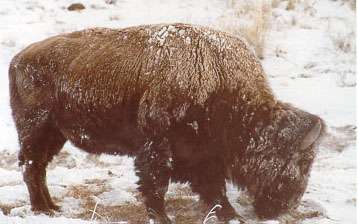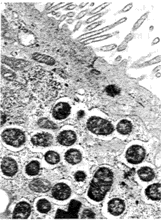|
DIMENSIONS: STUDY TEAM |
Brucella Abortus Biology in Yellowstone Bison

Brucellosis is a bacterium found worldwide that infects mammals.
The most significant symptom in bison is abortion of the first calf.
This was discovered after cattle herds in New England were suffering
from contagious abortions. The Bureau of Animal Industries began
research and control of the disease in 1911. Brucellosis was discovered
in Yellowstone National Park in 1917, most probably from contact
with settler's cattle. The disease is transmittable to humans, and
is known as undulant fever.

Hosts in North America of brucella organisms include: Livestock: Wildlife: Symptoms: The bacteria is remarkable in that it is an intracellular organism. Most bacterium inhabit the space between the host cells, whereas brucella enters the cell membrane in a viral fashion. The hosts immune system isolates the diseasesed cells in the lymphatic system, which may experience swelling. Other symptoms include abortion in the third trimester, swollen testes, swollen joints, decreased mammary milk supply, and other birth complications such as placental retention. In bison, cows abort only their first calf and can reproduce successfully thereafter. The birth material and milk are still contagious. Transmission: Transmission of the disease is by ingestion or contact with birth
products or aborted fetuses. Contagious individuals are cows. Bulls
may carry the disease and spread it venereally, but they do not
give birth and release the organism into the environment. Scavengers
eating the flesh of infected animals may acquire brucellosis. The major threat to the cattle industry from brucellosis is the
transmission from bison. The remaining herds are managed with the
difficult goal of eradication of the disease. Bison can transmit
the disease back to cattle but this has not occurred in the wild
outside of experimental conditions. Elk give birth away from the herd and there is less chance of transmission immediately after birth. The presence of brucella in elk may be continued by reinfection from the bison herds. The bison give birth within their group and other individuals are attracted to the birth products. Cattle give birth in similar circumstances and are drawn by a natural curiosity to birth products. Detection Current testing methods test for antibodies in milk and blood.
A single positive result declares the entire herd to be affected.
Animals incubating the bacteria but not diseased yet may test negative
for antibodies yet develop them shortly after. Naturally resistant
animals will test positive for antibodies, but blood and tissue
samples will prove negative for presence of the bacteria. Culturing
the organism can be difficult depending on where it is isolated
in the host's body. There are usually more positively tested
animals than there are contagious animals, and there are usually
more infected individuals than positive results. Eradication/Vaccination Eradication of Brucellosis is being pursued through a combination
of test and slaughter, and vaccination. The difficulties in
this goal are compunded by political issues, available resources,
and the failings of available testing methods. RB51 is effective at building resistance in cattle but causes some pregnant bison to abort their fetuses. During testing, this vaccine can be distinguised from the disease. Sources of Information Brucellosis in the Greater Yellowstone Area: Board on Agriculture |